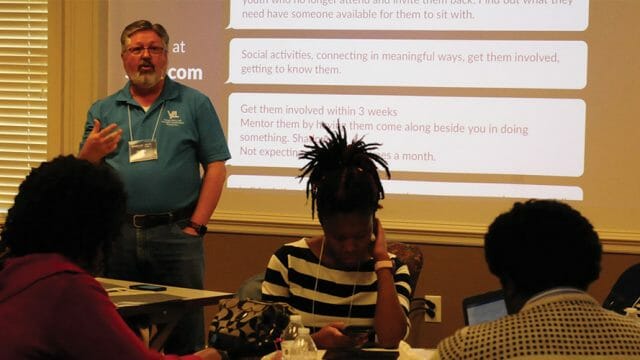Are people on social media really who they say they are?

No less a personage than Mark Zuckerberg himself, the founder of Facebook, has had to respond personally to claims of Russia’s impact on the 2016 election of the U.S. president. A political cartoon in the Chattanooga Times Free Presspictured a handheld device, its screen showing the message, “You have received a comrade request.” It’s becoming increasingly apparent that, whether the results of the election were decidedly affected, there was at least a deliberate intent to do so.
The growing awareness of the influence of social media—Facebook, Twitter, LinkedIn, Pinterest, Snapchat—in what has been termed an “information war” is bringing into focus ways in which thought and behavior may be shaped by unknown identities. Virtually every individual on the planet is on the receiving end of algorithms that have categorized him or her in various ways to receive given information. When this information, graphic or textual, is posted or shared in social media, there is an ever-greater need to assess its authenticity—of its content and its originator.
The validity of a source of information, in fact, has become an increasingly important concern. Who can be trusted? Who, exactly, is producing this intelligence?
Mere information is not truth. It may be good or bad, true or false. “You will not certainly die” (Gen. 3:4) was information—patently specious information. The material available in the social media today may be far more subtle than that original lie, making questions of source all the more critical. Analyzing the authenticity of sources begins with that of oneself. Who am I? Can I be trusted?
Am I Genuine?
In what is considered a classic pop song from the 1970s, a kind of soliloquy, the imagined thoughts of an astronaut from early in the history of human spaceflight describe the isolation and loneliness of space travel. There’s even a hint of alienation, no pun intended. After all, in a time when the very first efforts at space exploration consisted of rocketing a single individual into the far reaches of the stratosphere, it’s not difficult to imagine him feeling a world away from any other living being.
In thinking of those he has left back on earth, he sings, “I think it’s gonna be a long, long, time ‘til touchdown brings me ‘round again to find I’m not the man they think I am at home.” His role as an explorer in space has somehow changed him—or it’s possible his life even before leaving earth had been less than authentic. Time and great distance had raised the question of genuineness in his life and in his relationships.
Other lyrics, written by the same two songwriters who penned “I’m not the man they think I am,” returned to the theme of personal identity in another piece of pop music of the same decade: “Although I search myself, it’s always someone else I see.” Again, the question is raised: Who am I, really?
This uncertainty was nothing new to the decade of the seventies or to the beginning of the human exploration of space. Nor has it diminished since. The onset, so to speak, of the digital media have amplified all the more this question of the authenticity of the personal self. “I have been an Internet junkie since 1988,” writes Tom Beaudoin. “In that time, I have created dozens of personae related to my ‘self’ through virtual communications. Different selves that seem to belong to me emerge in online discussion groups, chat rooms, and private emails.”1 Beaudoin wrote this before the significant emergence of the social media.
“To thine own self be true.” Even though many may be unaware that these words were penned by some English playwright 400 years ago, there is surely a familiarity with them. Those who may ever stay honest with themselves will stay honest with others—they will be truly known.
The “Selfie” Message
The self, it’s asserted, is the standard by which all conduct and behavior should be judged. And social media have made opportunity to express one’s self in ways ranging from the subtle to the outrageous. To do so pictorially has brought about the selfie, a consciously devised snapshot of oneself in various inventive scenarios. Assuming that the intention is to communicate a message of some kind, the person posts a photo of himself or herself simply standing in front of the pyramids of Egypt, or bracing against the leaning tower of Pisa, or diving into a hot fudge sundae at the nearest ice cream shop.
Interestingly, this way of depicting oneself has become an expression of one’s happiness. Christianity Today describes sociological research suggesting that users of social media “are more concerned with appearing happy than with really being happy.”2 It may be perfectly understandable to want to avoid picturing oneself in miserable circumstances for the entire Internet to see. Looking at portraits of historical photographs—back to the very beginning of the medium—makes it clear that it took a generation or two even to learn to smile for the camera, to represent oneself in a positive way. But for all the careful curation of content in one’s representation in the social media, what happened to the saying, “to thine own self be true”?
An “Interchange of Masks”
There are, of course, many other purposes for what is posted in social media. One person likes photos that show what Fluffy, his adorable cat, is doing today. Another seeks to stay in touch with her past friends and classmates in a kind of ongoing school reunion. Another posts cherry-picked quotations from dead poets that few others could possibly care about. Yet another can take no longer the despicable portrayal in the media of her favorite candidate and shares clearly baseless posts that broach an opposite worldview.
Yes, these scenarios are described with a measure of cynicism. It’s all too easy to employ “snarkasm” in the lingua franca of our time. It isn’t as if everyone in social media posts and shares with the clear, conscious intent to put on an artificial front. It isn’t all about digital pretense and false identities. There’s certainly an open and innocent benefit of personal human-to-human contact.
But there’s also a great temptation to represent oneself in only positive ways. Beaudoin, again: “All living is an interchange of masks.”3 The instinct in human interaction of any kind to “put one’s best face forward” is all the more compelling on the Internet. For all the early claims that the Internet would liberate humankind from the natural inhibition to blend in, it has, instead, made it far more possible—far more tempting—to withdraw into a world of one’s own. For far too many, the promise of connectedness on a monumental scale has not proven out as well as hoped. The digital connectedness may indeed make it possible to be in touch with a greater number of others, but it also increases exponentially the exposure to the possibility of disapproval and derision.
So to “stay in touch” virtually, an online persona may take a form that’s an approximation of the self. And, through the process of disconnection by those who don’t share affinities, there’s the tendency to find oneself in digital relationship with only those who are of the same mind.
So in social media the answer to “Who am I?” becomes more and more “Someone just like you!” And, unless great care is taken, “Who am I?” may come to reflect the posts, shares, and tweets of some hateful unknown someone among Zuckerberg’s 2 billion subscribers.
1 Tom Beaudoin, Virtual Faith: The Irreverent Spiritual Quest of Generation X (San Francisco: Jossey-Bass Publishers, 1998), 121.
2 www.christianitytoday.com/ct/2017/march/theres-no-crying-on-social-media.html.
3 Tom Beaudoin, 104.








